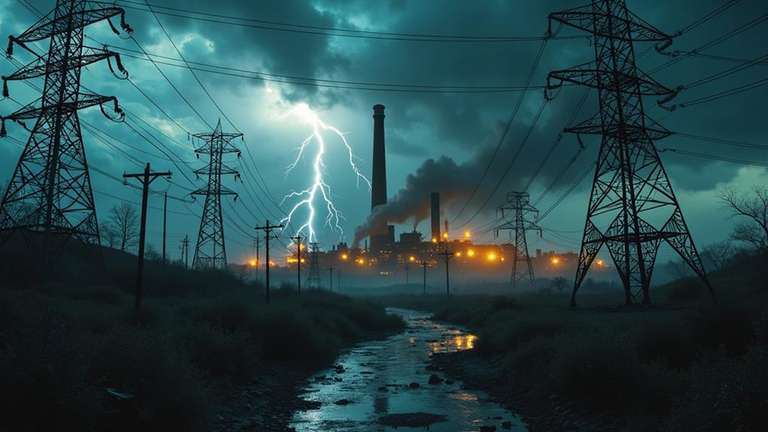What Happens When the Electric Grid Collapse?

Imagine waking up to a world where your lights don't turn on, your phone has no signal, and water stops flowing from your taps. When the electric grid collapses, you face more than just inconvenience; the very fabric of modern life begins to unravel. Hospitals experience critical equipment failures, food spoils without refrigeration, and public safety becomes a primary concern. How do communities cope, and what strategies can be employed to mitigate these dire consequences? Understanding these challenges emphasizes the necessity for a more resilient and sustainable approach to our energy infrastructure.
Causes of Grid Collapse
Grid collapses can arise from multiple causes, each disrupting the delicate balance of power supply and demand. Extreme weather events, such as storms, heavy snow, and extreme heat, are significant risks. These conditions can damage power lines and grid infrastructure, leading to widespread power outages. With the progression of climate change, the frequency and severity of these weather events are expected to increase, further straining the system.
Human error is another critical factor in grid failures. Mistakes by power plant operators can result in mismanagement of the power supply, causing outages. The aging infrastructure compounds this issue, as components in the U.S. grid average 40-50 years old. These outdated parts are more prone to failure, making it challenging to maintain a stable power supply.
Modern threats such as cyberattacks and electromagnetic pulses (EMPs) also jeopardize grid security. The interconnected nature of today's grids means that a successful cyberattack can cascade into a full-blown collapse. As these threats evolve, it is vital to fortify grid infrastructure to prevent catastrophic failures.
Immediate Impact on Society
When the electric grid collapses, crucial services like water supply and food preservation are disrupted, putting millions at risk. Communication systems fail, hindering access to emergency services and information. Economic activities stop, affecting hospital operations and everyday transactions.
Communication Systems Failure
Imagine a world where your phone suddenly goes silent, the internet disappears, and you can't make a simple call to check on a loved one. When the electric grid fails, communication systems collapse instantly. Cellular networks, landlines, and internet services all depend on electricity. The Federal Communications Commission (FCC) estimates that up to 90% of Americans rely on these services, so a grid failure would leave millions in chaos and confusion.
For instance, during the 2003 Northeast blackout, over 50 million people experienced disrupted communication. This disruption hindered the ability to contact emergency services or receive critical updates, slowing emergency responses and increasing risks. Without electricity, 911 call centers would struggle to operate, drastically increasing response times and jeopardizing public safety.
Public safety alerts and emergency broadcasts would also be severely limited, leading to widespread panic and misinformation. With no reliable way to disseminate information, people wouldn't know how to respond or protect themselves during the crisis. The immediate impact on society would be profound, as the failure of communication systems would leave communities isolated and vulnerable, amplifying the chaos and uncertainty of the situation.
Essential Services Disruption
A collapse of the electric grid plunges essential services into disarray, creating immediate and far-reaching impacts on society. Fundamental services disruption quickly follows, profoundly affecting daily life and public health. For example, water supply systems cease to function, making it challenging for urban areas, particularly high-rise buildings, to access clean drinking water. This disruption can lead to dehydration and hygiene issues.
Extreme temperatures worsen the situation as heating and cooling systems fail without electricity. Vulnerable populations, such as the elderly and young children, face significant health risks, including heat-related illnesses and hypothermia. The inability to maintain comfortable indoor temperatures can turn homes into hazardous environments.
Food preservation also suffers. Without power, refrigeration systems in homes and grocery stores fail, causing massive food spoilage. This leads to potential food insecurity as spoiled food becomes inedible. Grocery stores struggle to keep perishables fresh and process payments, complicating food distribution.
Here are three immediate impacts of an electric grid collapse:
- Water Supply Issues: Inaccessibility to clean drinking water.
- Temperature Extremes: Increased health risks such as heat-related illnesses and hypothermia.
- Food Spoilage: Potential food insecurity due to refrigeration failures.
Thus, a power outage disrupts fundamental services, posing severe health risks.
Economic Activities Halt
An electric grid collapse can immediately halt economic activities, causing financial turmoil that could cost billions annually. Imagine walking into grocery stores only to find shelves empty because food preservation systems failed, leading to spoiled goods. Without power, payment processing systems can't function, making it impossible to complete purchases. These disruptions result in significant revenue losses for businesses and potential food shortages for communities.
Healthcare services are also severely impacted. Surgeries and essential medical care rely on continuous power. Equipment failures can be life-threatening, jeopardizing patient care and potentially leading to tragic outcomes.
Transportation systems, including public transit and logistics, face massive setbacks. Without electricity, trains, subways, and traffic lights cease to function, causing gridlock and delaying the movement of goods and services. This further disrupts economic activities and supply chains.
Unemployment rates can skyrocket as businesses struggle to operate without reliable power. Temporary closures could become permanent for some, leading to job losses and increased economic instability. All these factors underscore the critical importance of a stable electric grid for maintaining societal functions.
Water Supply Challenges

When the power grid fails, water supply systems that rely on electric pumps cease functioning, cutting off access to clean water for millions. High-rise buildings are particularly vulnerable, as they depend on these pumps to deliver water to upper floors. Without power, residents face significant challenges in obtaining the water necessary for daily activities.
The loss of electricity also compromises sewage systems, creating potential public health hazards. Without effective wastewater treatment and disposal, sanitation issues can arise, threatening entire communities. Additionally, urban areas risk rapid contamination of drinking water supplies due to the failure of water treatment plants. This poses severe health risks, as untreated water can harbor harmful bacteria and toxins.
To address these challenges, emergency response plans must focus on alternative water sources and storage solutions. Key strategies include:
- Install backup generators: Ensure critical water supply and treatment facilities remain operational during power outages.
- Develop community water storage: Establish reserves that can be accessed during emergencies.
- Promote individual preparedness: Encourage households to store an adequate supply of bottled water.
These measures are essential to maintaining access to clean water and ensuring public health during power outages.
Food Preservation Strategies
In the event of a power outage, it's crucial to preserve your food without electricity. Stock up on non-perishable items and use coolers with ice to keep perishables safe temporarily. For long-term storage, consider methods like canning and drying to ensure your food supply remains secure.
Utilizing Non-Electric Methods
When the electric grid fails, non-electric methods for food preservation are essential. Here are three effective strategies to keep your food safe and edible:
- Nonperishable Foods: Stock up on canned goods, dried beans, and grains. These items don't require refrigeration and can last for years if stored properly. They provide essential nutrients and are reliable during power outages.
- Canning, Pickling, and Dehydrating: These techniques extend the shelf life of fruits and vegetables. Canning and pickling use heat and acidic solutions to preserve food, while dehydrating removes moisture, inhibiting bacterial growth.
- Coolers and Root Cellars: Use coolers with ice to maintain a safe temperature for perishables temporarily. Root cellars offer a cool, dark environment, ideal for storing root vegetables for extended periods.
Long-Term Storage Solutions
Ensuring a steady food supply during an electric grid collapse is crucial. Stockpiling non-perishable food items such as canned goods, dried grains, and legumes is essential, as they can last for years without refrigeration. During prolonged power outages, it's important to note that food in a full freezer can remain safe for up to 48 hours, while food in a refrigerator can stay safe for about four hours if the door remains closed.
To extend the preservation of perishable items, using coolers filled with ice is effective. Ensure you have an adequate ice supply on hand. Discard any food exposed to temperatures above 40 degrees Fahrenheit for more than two hours to prevent foodborne illnesses. Regularly check and rotate stored food supplies to avoid waste and ensure availability during emergencies.
Here's a quick reference table:
| Storage Method | Duration | Key Points |
|---|---|---|
| Canned Goods | Years | Long-term storage, no refrigeration needed |
| Dried Grains/Legumes | Years | Non-perishable food |
| Full Freezer | Up to 48 hours | Keep closed to maintain temperature |
| Refrigerator | Up to 4 hours | Keep closed to maintain temperature |
| Coolers with Ice | Varies | Essential for prolonged outages, requires ice supply |
Medical Equipment and Needs

Ensuring the continuous operation of medical equipment during a power outage is crucial for patient safety. Power failures can lead to the malfunction of vital devices like ventilators and infusion pumps, posing severe health risks. Disruptions in surgical procedures and critical care can result in adverse outcomes for patients.
To mitigate these risks, consider the following measures:
- Backup Power Systems: Hospitals and medical facilities must have reliable backup power systems, such as generators, to maintain the operation of essential medical equipment during outages. Regular maintenance and testing are crucial to ensure these systems are dependable.
- Personal Power Outage Plans: Individuals who rely on electricity-dependent medical devices should have a comprehensive power outage plan. This includes alternative methods for medication storage and a list of emergency medical contacts. Discuss these plans with healthcare providers to ensure all contingencies are covered.
- Support for Vulnerable Populations: People with chronic illnesses or disabilities that depend on electricity for their medical devices face increased health risks during blackouts. Community support systems and local healthcare services should be prepared to offer assistance in these situations.
Light and Safety Measures
When the electric grid collapses, maintaining adequate lighting is essential to prevent injuries and ensure safety. Without sufficient light, tripping and accidents are more likely to occur. It's crucial to stockpile alternative light sources like candles, solar-powered lights, and flashlights to ensure visibility in the dark. Regularly check your emergency lighting supplies to confirm they are functional and ready for use during outages.
To visualize what you might need, here's a handy table:
| Item | Purpose | Frequency of Check |
|---|---|---|
| Candles | Basic light source | Monthly |
| Solar-powered lights | Renewable light source | Every 3 months |
| Flashlights | Portable light source | Monthly |
| Carbon monoxide detectors | Safety from CO poisoning | Every 6 months |
| Fireplaces | Safe indoor fire management | Before use |
In addition to lighting, having functional carbon monoxide detectors is crucial. When using alternative light and heat sources, the risk of carbon monoxide poisoning increases. Ensure these detectors are operational and placed appropriately. By taking these precautions, you will improve your safety and visibility, minimizing risks during a power grid collapse.
Generator and Carbon Monoxide Safety
Maintaining visibility and safety with adequate lighting is just the beginning. Using a generator during a power outage can keep vital appliances running, but it's crucial to understand the associated risks and safety measures. Generators emit carbon monoxide (CO), a colorless and odorless gas that can cause poisoning. Follow these steps to ensure safety:
- Operate Generators Outdoors: Always use your generator outdoors, at least 20 feet away from windows, doors, or vents to prevent CO buildup inside your home.
- Install CO Detectors: Place carbon monoxide detectors on every level of your home. These devices provide early warnings if CO levels become dangerous, giving you and your family time to evacuate.
- Maintain Your Generator: Keep your generator dry and shielded from the elements to avoid electrical hazards. Use heavy-duty extension cords rated for your generator's output to prevent overheating. Allow the generator to cool before refueling to minimize fire risks.
Seasonal Survival Tactics
Surviving a power outage necessitates adapting your strategies to the current season.
Summer: Staying hydrated is crucial. Ensure you have at least one gallon of water per person per day to prevent dehydration, as extreme heat increases your hydration needs. Stockpile bottled water and have a plan to purify additional water if necessary.
Winter: Maintaining warmth is essential. Wear layers of dark, heavy clothing to trap heat, and consider off-grid heating options like propane heaters, wood stoves, or candles. Ensure proper ventilation to prevent carbon monoxide buildup. Regularly check on vulnerable individuals for hypothermia symptoms, such as confusion and a slow heart rate, and move them to warmer areas if needed.
General Tips: Regardless of the season, have emergency lighting supplies like flashlights and batteries to reduce the risk of injuries during power outages. For cooking, use outdoor grills or camp stoves to avoid the dangers of indoor gas stove emissions.
Building Community Resilience
Building community resilience is essential for effectively navigating the challenges posed by power grid failures. When the grid goes down, communities face immediate and long-term disruptions. To address these challenges, agencies like FEMA, HHS, and NOAA must collaborate closely. It's not just about restoring power; it's about safeguarding public health and maintaining safety, especially during extreme weather events.
Here's how you can contribute to building community resilience:
- Engage in Community Planning: Participate in transparent discussions about load shedding and ensure protocols are in place to protect critical medical services, which is vital for vulnerable populations reliant on electricity for their health needs.
- Support Interagency Collaboration: Advocate for comprehensive Memoranda of Understanding (MOUs) among key agencies to enhance public health and emergency response planning. This is crucial during extreme weather events that often destabilize the power grid.
- Promote Social Cohesion: Strengthen social ties within your community by involving everyone in resilience planning. This inclusive approach ensures equity and prepares the community to handle emergencies together.




